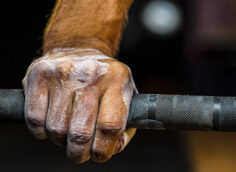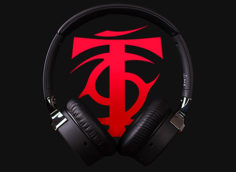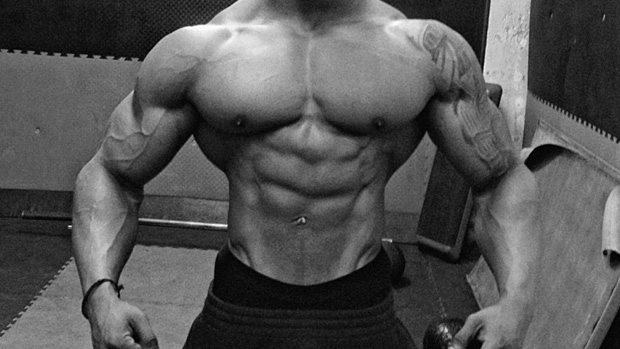Back in the article Sure Fire Fixes for Weak Points, four Testosterone coaches weighed in with some general tips for bringing up lagging bodyparts.
Unfortunately, one of the problems with any weak point attack plan is the dreaded expression, 'it depends.' The effectiveness of the strategy depends on a number of factors, including your genetics, your current level of development, and of course, what body part you happen to be targeting.
In other words, a kick-ass routine to turn your calves into cows likely won't do diddly squat for your droopy pecs unless you're so genetically gifted (or so de-trained) that you can make gains from a few rounds of P90X followed by some Bikram yoga.
With that in mind, we decided to pick the brains of a few of our contributors for some proven routines and tips to target common weak points. First up on the list? Every high school kids top priority, the biceps.
Tim Henriques

Tim Henriques may be a powerlifter and strongman competitor, but as director of NPTI, a personal training certification course, he also knows a thing or two about training for show.
When asked for his favorite weak point biceps routine, it wasn't surprising given Henriques' background in strength sports that the big factor in determining what routine he'd recommend is the client's overall strength levels.
"Strength is the first thing I look at," he says. "If a client can't barbell curl at least half his bodyweight with good form, then they need to get stronger. So for those weaker guys, I'd have them perform this biceps routine."
A. EZ Bar Power Curl, wide grip 5 sets x 8 (warm-up), 12, 10, 8, 6 reps. Increase the load each set. Follow with a "burnout" set of 20 reps, performed with a narrow grip.
(Perform with a little swing, just as much as necessary to complete each rep. That said, you're training biceps here; you shouldn't get an epic calf and lower back pump.)
B1. Supinated DB Curls 3 x 8-12 reps. Rest 30 seconds.
B2. DB Hammer Curls 3 x 8-12 reps. Rest 2 minutes.
C. EZ Bar Reverse Curl 3 x 12, 10, 8 reps. Increase the load each set.
"They should do this on a day when their biceps are fresh, so with chest or shoulders, not after back," says Henriques. "In terms of frequency, I'd say once a week is fine, although twice a week is tolerable for a month."
"Going heavy on back training on another day of the week with 45-Degree Bent Over Rows, pull-ups/chin-ups, and close neutral grip rows will also help as well," he says.
Henriques takes a significantly different approach for stronger trainees looking to improve their biceps. "If a trainee is relatively strong, meaning that they can curl half or preferably 75% of their bodyweight, then their arms are likely decent sized but probably need better detail," he says. "A lot of bigger guys have decent arms but no peak on their biceps, which indicates an underdeveloped long head of the biceps."
"The following giant-set pre-exhaustion program emphasizes the long head to develop the peak,"he says.
A1. Double DB Preacher Curl 3-4 x 8-15 reps. 4010 *. No rest.
* 4-second count on the negative.
Hold the dumbbells like a bar, palms up, dumbbells touching the whole time.
A2. Straight Bar Strict Curl 3-4 x 6-12 reps. 2010 *. No rest.
* 2-second count on the negative.
Use a straight bar. To minimize cheating, put your upper back and butt against the wall.
A3. Alternating Crossbody DB Curl 3-4 x 10-12 reps. 2010. Rest two minutes and repeat giant set for a total of 3-4 rounds.
Hold the dumbbells like you were going to do a lateral raise. Curl the weight to the opposite front delt while keeping your palm facing the ceiling.
Shelby Starnes

Physique coach and nationally ranked bodybuilder Shelby Starnes frequently gets asked by aspiring bodybuilders for a biceps specialization routine, so much so, that he has a very tongue-in-cheek response: "Synthol," he says.
Uh, thanks, Coach!
"No seriously, poor biceps development can be caused by a number of things," says Starnes. "The most common problem is failing to select the right parents, meaning poor genetics."
Poor genetics is the ultimate equalizer. According to Starnes, you can eat like a machine and train like a champion but even the best biceps specialization routine won't work optimally if your family tree looks more like a weeping willow.
"If you don't have good biceps insertions, your pipes will never look like Albert Beckles, regardless of how many sets of concentration curls or fancy superset routines you do," he says.
Interestingly, Starnes says another common cause for lackluster biceps development is overtraining, and conversely, undertraining. "Some guys like training biceps more often than they eat it seems, while others fall prey to the 'it's a tiny muscle group so just three sets of lat pulldowns is enough to stimulate wicked gains.' Obviously, you need to find a happy medium here," says Starnes.
"I can't tell you what your ideal frequency is, as you have to figure that out for yourself. But if your biceps aren't growing the frequency would be the first thing I'd change. Sometimes just adding or subtracting a day or two of rest is enough of a change to get things growing again.
"Just be mindful that extreme frequency or infrequency is almost never the right formula."
If you've played with your frequency and still aren't seeing growth, Starnes says to borrow a trick from Mr. Biceps himself, Charles Poliquin, and directly train the brachialis.
"The brachialis is a small muscle that runs under the biceps that when developed maximally will push the biceps up, giving it the illusion of more thickness as well as a peak," he says. "It won't turn your biceps into Arnold's, but it will help maximize whatever you've got."
The best biceps exercises to target the brachialis are any where the palm is semi-supinated (neutral) or pronated (palms down), so variations of hammer curls and reverse curls.
One effective brachialis routine popularized by Charles Poliquin uses the Doublé Method, which involves using the same exercise twice within a tri-set. Perform this bad boy every 5 days or so to add serious girth to your brachialis and forearm flexors.
A1. Paused, Medium-Grip, EZ Reverse Curls 3 x 4-6 reps. 4022*. Rest 10-seconds.
A2. Seated DB Hammer Curls 3 x 4-6 reps. 3020. Rest 10-seconds.
A3. Paused, Medium-Grip EZ Reverse Curls 3 x 4-6 reps. 4022 *. Rest two minutes and repeat cycle.
* Pause taken at 20 degrees of concentric phase.
Nick Tumminello

Baltimore-based personal trainer and strength coach Nick Tumminello is known for creating effective, out of the box routines for his diverse clientele of pro athletes, MMA fighters, and physique competitors. Coach Nick already addressed biceps for Testosterone readers in his Unconventional Workout series but still receives frequent inquiries from trainees looking for new ways to kick start growth in their upper arms.
One way in which Coach Nick will kick-start lagging biceps is to bump up the frequency to two sessions per week, but provide a radically different stimulus on each day.
Day 1
A1. Chin-Ups, 4-5 x 6-8 reps. Rest 10 seconds.
A2. Offset* Dumbbell Alternating Biceps Curl, 3-4 x 8-10 reps. 3010. Rest 10 seconds.
A3. EZ Bar Preacher Curl, 3-4 x 8-10 reps. 3010. Rest two minutes between cycles.
*Offset dumbbell curls require the dumbbell be held with an asymmetrical grip, with the thumb and index finger pressed against the inside plate of the dumbbell.
Day 2
A. Fat Grip Biceps 28's, 2 x 28 reps. 2-minute rest between sets.
Note. Use Fat Gripz if you don't have access to thick-grip dumbbells.
B. 60/30 Biceps Band Curls, 2 sets. 2-minute rest between sets.
(Both workouts can be stand-alone workouts or integrated into an existing upper-body dominant workout.)
"On the first session, I prescribe a tri-set consisting of chin-ups, followed by slow eccentric dumbbell curls and preacher curls," says Nick. "Chin ups are a fantastic biceps movement as the combination of the heavy load (bodyweight) and long range of motion cause a lot of fiber trauma.
Immediately follow the chins with some slow-eccentric work from different joint angles and you can thoroughly trash the biceps."
"Expect some deep soreness," he says. "Allow at least two days rest before hitting day two."
Day two of Coach Nick's weak-point biceps routine flips the stimulation from heavy loads and eccentric trauma to higher volume, high velocity 'pump' training. It consists of only two exercises for a total of four sets, but if you follow the routine as directed you'll perform far more total reps for your biceps than you likely ever have!
The routine starts with a favorite of Coach Nick's, Biceps 28's performed with a fat grip bar. "This is a spin on the classic 21's method made popular by Arnold Schwarzenegger," says Coach Nick. "I also like to use fat grip barbells or dumbbells to get in some crucial grip work," adds Nick.
The 28's Method is as follows:
7 reps halfway down curls w/pronated (palm down) grip
7 reps half way up curls w/Neutral grip (palms facing each other)
7 reps full ROM supinated grip (palms up)
7 seconds midrange isometric hold (any grip you wish)
Of course, these are all done without putting the weight down.
Following these two killer sets, Coach Nick prescribes two more sets of another painfully effective biceps pumper: the 60/30 Band Curl.
Coach Nick uses a band because it allows you to move fast without gaining momentum. He recommends using a 1/2-inch band for weaker individuals and a 1-inch band for stronger folks.
Perform 60 reps in 30 seconds x 2-4 sets with 1-2 minute rest. If you can't complete all 60 reps in 30 seconds, the band is too heavy.
Don't scoff at this seemingly 'girlie' exercise. The skin-tearing pumps are worthy of the cover of Flex magazine.
Krista Schaus

Bodybuilder, powerlifter, and physique coach Krista Schaus isn't like most females, for the simple fact that she's stronger than most guys.
When she's not helping her clients win bodybuilding, powerlifting, and physique modeling contests through her business Defining Edge Fitness, Krista is usually competing herself in either powerlifting or bodybuilding.
Krista is no stranger to biceps discussions as the blond powerhouse has a set of guns that would cause your typical Fifth Avenue fashionista to faint in her Manolo Blahniks. Yet if you think her formula is simply 'bigger guns = better guns,' think again.
"Biceps size is more qualitative than quantitative," she says. "What I mean is, it's not the number that matters as much as what they look like."
"If you don't believe me, measure any obese persons biceps. What about the fat lady at the circus? She probably has 20-inch arms. Do you want that?"
In a sport like bodybuilding where illusion trumps numbers, Krista says conditioning is much more important than overall arm size. "My biceps look their biggest when I compete, but they actually measure at their smallest," she says. "So if you want to look like your biceps have grown, get leaner."
Schaus says getting single-digit lean does more for your arms than just provide the illusion of more size. The catabolic process of whittling away excess bodyfat over several months serves to set the body up for a prime anabolic rebound period right after the diet ends and the calories and training loads shoot back up to normal.
"Diet for three months and then, when you get silly lean, train two times a day for two weeks and eat a mammoth amount of good clean food. Your arms could actually grow an inch," says Schaus.
But before you toss your current bulking plans out the window and order a three months supply of HOT-ROX, Schaus has a warning for every biceps-training junkie. "Big biceps are built over a lifetime of loving the physical work of training, not being desperate for superficial outcomes."
"Sure fire fixes work, but you need a foundation of quality size and strength. And if size and strength is your real weak point, there's no quick fix for that."
Summing Up

Four coaches, four different ways to target weak or lagging biceps. So if the goal is to bring up a lagging biceps, what should you do?
• First, play with your frequency. A bump from once a week to twice a week is often all that's required to get back on the right side of the adaptation curve. Another frequency tweak that work is switching from training biceps after back to hitting them after shoulders or chest, when they're "fresher." On a related note, a high volume "arm day" combined with a few sets of biceps thrown in after a larger muscle group a few days later is a near foolproof scenario.
• If you can't standing barbell curl at least half your bodyweight for one good rep, then make getting stronger your focus. Correcting a strength imbalance can be the simplest way to kick start growth, and for good reason: All things being equal, a stronger muscle is usually a larger muscle.
• If you're decently strong but lack biceps shape or detail, start playing with higher volumes and various giant set routines. High volume routines are not a replacement for heavy iron, but bodybuilders have testified to the importance of getting a good skin tearing biceps pump for a hundred years. Maybe you should listen?
• Target the brachialis, the long head, and the grip. In fact, targeting each of the above in four-week blocks may leave you sporting dramatically different looking biceps after the 12 weeks are done.
• Get strong in your supinated grip chin-ups. Use slow eccentric tempos and make sure you get a full stretch and a pause in the bottom position. Enjoy every painful second.
• Play with different joint angles. Don't just do seated and standing curl variations. Break out the preacher or Scott bench and make friends with the incline bench. Performing a giant set of incline dumbbell curls using a different angle of inclination each set will certainly introduce you to your long lost biceps long head.
• Lean muscles appear larger. A 16-inch arm on a single digit bodyfat physique looks far more impressive than a set of 19-inchers paired with a 40-inch waist. Low bodyfat also means greater vascularity, and nowhere is this more noticeable than in the biceps.
• Experiment with twice a day training. A fast three-week block of training arms twice a day can deliver huge results. Combine this with the anabolic effects of a post-diet rebound and you'll be giving away all your medium pink Abercrombie polo shirts. Or at least cutting off the sleeves. On second thought, just give them away. Seriously.
• All the biceps specialization routines in the world aren't worth a fart in a hurricane if you don't have appreciable levels of strength in the Big 3. If you don't even know what the Big 3 are then you're probably pretty damn weak and shouldn't have bothered even reading this article to begin with. Sorry about that. Although feel free to still give your pink polos away.
Conclusion
Going through life with biceps that resemble string cheese is no fun, and it's also not necessary. While you can't pick your parents, even the most genetically challenged lifter can improve the size and strength of their elbow and forearm flexors. How much size and strength boils down to a simple math equation:
Determination x (Genetics + Smart Programming) = Progress.
The genetics value is preset; you can't change it. You can plug in some of the tips in this article into the programming field. As for the determination variable? Well, that's all up to you.
Now get growing!





